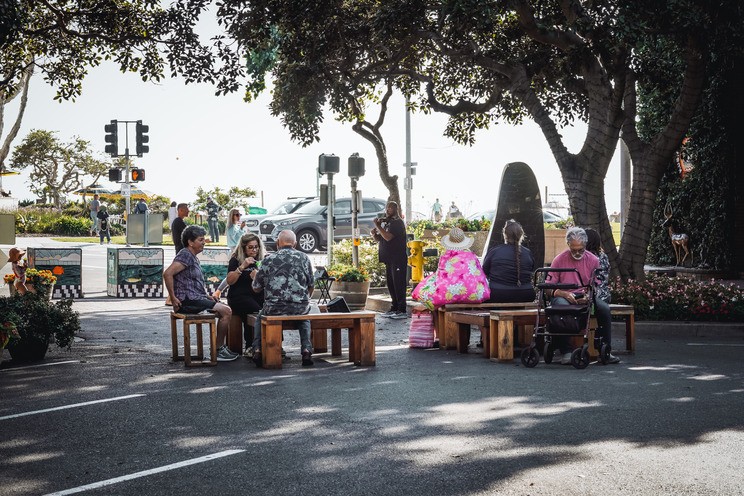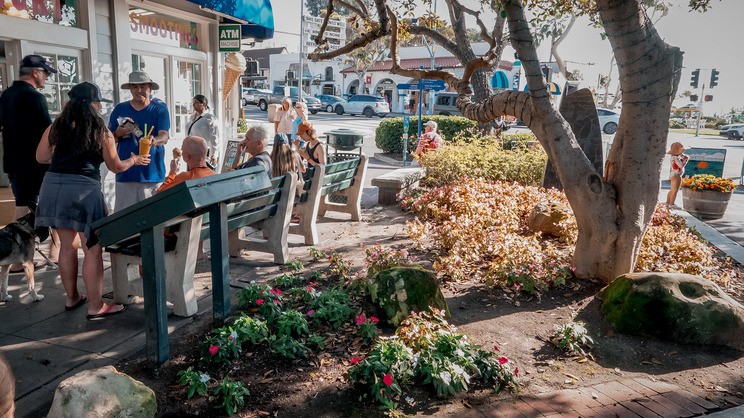Why do some street corners buzz with life, while others remain eerily quiet? The late urbanist William H. Whyte had an answer: triangulation. This concept can explain why some public spaces naturally draw people in and encourage social interaction. Triangulation refers to the way certain objects, activities, or experiences create connections between people—whether it’s a street performer, an inviting bench, or a well-placed café.
Take, for instance, this street corner in Laguna Beach, California. At first glance, it might seem like just another intersection, but in reality, it’s a social hotspot—a place that naturally attracts people and fosters interaction.
A Violinist Catalyzes Social Life
On this particular day, a violinist is the catalyst that brings the space to life. Passersby pause to listen, drawn in by the music. Some stand and chat, others watch from a distance, and children—naturally uninhibited—step forward, mesmerized.


But the magic of this space isn’t just about the performer. It’s the behavior setting that makes the performance possible.
- Inviting seating and greenery – Benches, lush landscaping, and ample shade create a human-scaled environment, making it a place where people want to linger, adjacent to the violinist.

- Safe from traffic – The street closure ensures that people can gather comfortably, free from the noise and hazards of passing cars. This single intervention—limiting vehicular access—transforms the space from a simple sidewalk into a space full of potential.

- Visual complexity and detail – The fine architectural elements, flower beds, and public art provide an engaging backdrop. These small details help create a sense of intimacy and intrigue, encouraging people to explore and engage with their surroundings.

The Role of Active Edges: Retail as a Placemaker
Great public spaces don’t exist in isolation—they interact with the buildings around them. The edges of a place can determine its success.
- On one side of the street corner, an ice cream shop serves as a natural gathering point, attracting families and passersby.

- Across from it, a storefront rich with nooks and crannies adds a sense of visual intrigue. These small alcoves provide a feeling of comfort and enclosure, subtly satisfying our human need for complexity and protection in our environment.

These elements all work together—they triangulate—to create a dynamic, people-centered environment. Whyte’s genius was in recognizing that placemaking isn’t just about designing spaces; it’s about choreographing interactions. This isn’t just a corner—it’s a micro-destination where strangers can become neighbors and where a space becomes a place.

In Public Spaces, Scale Matters
Placemaking happens at the scale of a street corner. The best public spaces are intimate enough to allow for eye contact and spontaneous interaction. Interestingly, this street corner aligns almost perfectly with Christopher Alexander’s recommendation in A Pattern Language:
“A town needs public squares; they are the largest, most public rooms. But when they are too large, they feel deserted. They work best when they have a diameter of about 60 feet.” (Pattern 61: Small Public Squares)
This simple but powerful design principle is evident in many successful public spaces. Small-scale, well-defined spaces create a sense of enclosure without feeling confining—a quality that naturally fosters social interaction.

My Fascination with Placemaking and Urban Design
My own interest in placemaking and urban design began with a paperback copy of William Whyte’s The Social Life of Small Urban Spaces. It was a revelation—an eye-opening look at the seemingly small but profound details that shape our experience of cities. Since then, I’ve drawn inspiration from countless researchers, designers, and planners who have built on Whyte’s work. And of course I’ve been inspired by my mentors Fred Kent, Steve Davies and Kathy Madden at Project for Public Spaces, where I spent 20 years.
But at the core, the lesson remains simple: great places don’t happen by accident. They emerge from a thoughtful balance of design, activity, and human connection.
This street corner in Laguna Beach, California isn’t just a pretty intersection—it’s a lesson in how to turn ordinary urban spaces into extraordinary places of social life.

Share other examples and pictures, please!

